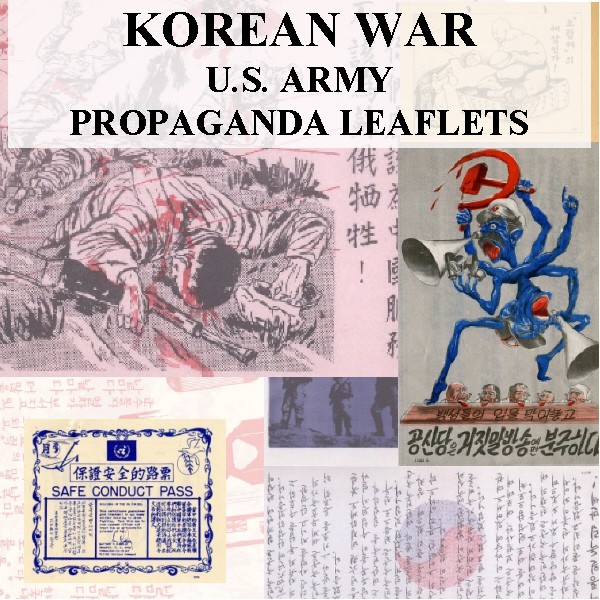
Description
Eighth Army Psychological Warfare in the Korean War
Timeline of Main Events (Based on the Source)
- June 25, 1950: The Korean War begins. This date also marks the starting point for the “Report on the Psychological Warfare Conducted by the Eighth Army Units in Korea.”
- Early Stages of the Korean War (June 1950 onwards): The United States Eighth Army begins psychological warfare operations in Korea. The Psychological Warfare Section, Far East Command, Headquarters Eighth United States Army Korea (EUSAK), Military Intelligence Section, is responsible for creating propaganda leaflets.
- Throughout the Korean War (1950-1953):The Eighth Army develops and distributes a wide range of propaganda leaflets targeting North Korean soldiers and civilians.
- Leaflets aimed at soldiers encourage surrender, promising food, medical treatment, warmth, and safety as Prisoners of War (POWs). “Safe Conduct” passes are a common feature.
- Leaflets aimed at civilians warn them to avoid battle lines and provide instructions for refugees.
- Political leaflets portray North Korean soldiers and the Korean people as pawns of Korean Communists, China (specifically Mao Zedong), and the Soviet Union (specifically Josef Stalin).
- North Korean leader Kim Il Sung is depicted negatively, as becoming prosperous while his people suffer.
- Intelligence gathered, likely through various means including POW interrogations, influences the content and targeting of the leaflets.
- The effectiveness of propaganda campaigns is gauged through interrogations of North Korean POWs.
- The Eighth Army faces challenges in its propaganda efforts, including the widespread illiteracy among North Korean soldiers.
- The Eighth Army utilizes airdrop packets for the distribution of propaganda leaflets.
- May 1, 1951: Leaflet 8112 is widely distributed over enemy territory. This leaflet contrasts a seemingly prosperous May Day parade in 1946 under a thin Kim Il Sung with an impoverished May Day in 1951 under a heavy Kim Il Sung, highlighting the alleged broken promises of the Communist regime.
- During the Korean War (Specific date unspecified): Leaflet 8123 circulates, emphasizing the theme of Communist Chinese forces exploiting Korea and using North Korean soldiers to bear the brunt of the fighting.
- During the Korean War (Specific date unspecified): Leaflet 8163 targets North Korean People’s Army guerrillas behind UN lines, offering them a choice between death and humane treatment from Republic of Korea National Police upon surrender. It also instructs ROK forces to treat surrendering soldiers according to international law.
- July 27, 1953: The Korean Armistice Agreement is signed, ending the active combat of the Korean War. This date marks the end point for the “Report on the Psychological Warfare Conducted by the Eighth Army Units in Korea.”
- February 1954: The “Report on the Psychological Warfare Conducted by the Eighth Army Units in Korea” is prepared by various branches of the G3 Psychological Warfare Division and officers from the First Loudspeaker and Leaflet Company. This report provides a chronological history and analysis of the psychological warfare operations.
Cast of Characters and Brief Bios (Based on the Source)
- Kim Il Sung: The leader of North Korea during the Korean War. US propaganda leaflets portrayed him as growing wealthy and overweight while the North Korean population suffered under Communist rule.
- Mao Zedong: The Chairman of the Communist Party of China. US propaganda depicted him as one of the Communist leaders (along with Stalin and Korean Communists) exploiting Korea for their own political and ideological gains.
- Josef Stalin: The leader of the Soviet Union. Similar to Mao Zedong, US propaganda portrayed him as a foreign power manipulating Korea for Communist objectives.
- Lee Soon Yong: The Minister of the Republic of Korea (ROK). His name and title are featured on Leaflet 8163, providing assurance of humane treatment to North Korean guerrillas who surrender to ROK National Police.
- Personnel of the Psychological Warfare Section, Far East Command, Headquarters Eighth United States Army Korea (EUSAK), Military Intelligence Section: This unnamed group was responsible for the creation and production of the US propaganda leaflets during the Korean War.
- Officers from the G3 Psychological Warfare Division and the First Loudspeaker and Leaflet Company: These individuals were involved in conducting psychological warfare operations and later in preparing the “Report on the Psychological Warfare Conducted by the Eighth Army Units in Korea.”
- North Korean Soldiers: The primary target of many US propaganda leaflets, which aimed to demoralize them, encourage surrender, and provide “Safe Conduct” during the war.
- North Korean Civilians: Another target group for US propaganda, with leaflets designed to warn them about the dangers of battle zones and provide guidance for refugees.
- Republic of Korea National Police: Mentioned specifically in Leaflet 8163 as the recipients of surrendered North Korean guerrillas, instructed to provide humane treatment.
- Communist Soldiers (specifically Chinese): Depicted in leaflets like 8123 as exploiting the Korean conflict for their own long-term strategic advantage
Korean War: United States Army Propaganda Leaflet Program
715 pages of United States Eighth Army propaganda leaflets, documentation, and a history of psychological warfare used during the Korean War.
U.S. ARMY DISTRIBUTED KOREAN WAR PROPAGANDA LEAFLETS
365 pages of leaflet images and 250 pages of documentation about the leaflets. These propaganda leaflets were created by the Psychological Warfare Section, Far East Command, Headquarters Eighth United States Army Korea (EUSAK), Military Intelligence Section. The documentation pages contain descriptions of the material on the leaflets and includes English translations of the Korean and Chinese text on the leaflets. The Army description sheets also contain remarks and information about the targets, content, and rationale behind the issuing of the leaflets. The sheets often mention the intelligence that was gathered, which influenced the content and targeting of the leaflet.
The leaflets had different proposes and targets. Those aimed at soldiers often encouraged surrender to avoid death from fighting UN forces. North Korean soldiers were promised that as POWs they would experience the replacement of the hardships of war, with food, medical treatment, warmth and safety. A common theme among the leaflets were “Safe Conduct” passes that guaranteed the bearer good treatment. These leaflets were intended to make North Korean fighters less fearful about their future after surrendering. Those aimed at civilians warned of the necessity to avoid battle lines. Others instructed conduct for refuges.
Many political leaflets displayed the Korean people and North Korean soldiers as pawns of Korean Communists, China, and the Soviet Union. Leaders such as Mao Zedong and Josef Stalin were portrayed as exploiting Korea for their own ends. North Korean leader Kim Il Sung was literally publicized as getting fat off the suffering of Korea.
REPORT ON THE PSYCHOLOGICAL WARFARE CONDUCTED BY THE EIGHTH ARMY UNITS IN KOREA, 25 JUNE 1950 THRU 27 JULY 1953.
This 105 page report was prepared in February 1954 by several branches of the G3 Psychological Warfare Division and by officers from the First Loudspeaker and Leaflet Company. The report provides a chronological history of the events related to psychological warfare operations during the Korean War. The narrative chapters tell of the logistics involved in the production and delivery of the leaflets. The report tells how interrogations of Korean POWs were used to gauge the effectiveness of the propaganda campaigns. The report covers the problems faced by the personnel producing the leaflets, such as the fact that most Northern soldiers were illiterate.
COMMUNIST LEAFLETS
In addition to the material described above, this collection contains six Communist English-language propaganda leaflets, that Northern forces distributed to U.S. and U.N. forces.
American Leaflet Highlights
Leaflet 8112
This leaflet was widely distributed over enemy territory on May 1, 1951. At the top panel of this leaflet we see a May Day parade in 1946. Happy and healthy Korean workers march past a skinny Kim Il Sung. At the bottom panel is May Day 1951. Here we see emaciated works marching past the North Korean leader who is now heavy. On the reverse written in Korean is the message, “North Korean fellow citizens, look at these pictures. The bald falsehood in Communist’s promises has been brought to light just this: There is neither freedom, equality, peace nor rest under the domination of Communist dictators. Workers and farmers are dropping day after day of hunger and poverty so a handful of communist bosses may live in luxury.”

Leaflet 8123
This leaflet plays on the theme that in the Korean War, Communist Chinese forces were exploiting Korea. In the illustration a North Korean soldier is in the foreground, in the background are two Chinese soldiers. One Chinese soldier says to the other, “Let him do the heavy fighting. When the Koreans are weakened we shall have the whole country.”

Leaflet 8163
The targets of this leaflet were North Korean People’s Army guerrillas who were behind U.N. lines. The illustration shows two options, death in the hills, or good treatment from a Republic of Korea National police officer. The leaflet had a second purpose, to reiterate that ROK forces should not mistreat surrendering North Korean forces. In Korean the leaflet says, “To the Republic of Korea National Police: The Partisans with this leaflet desire to cease resistance. Give them humane treatment in accordance with the provisions of International Law,” signed Lee Soon Yong, Minister of the ROK.

Leaflet 8155
Documentation for Leaflet 8155
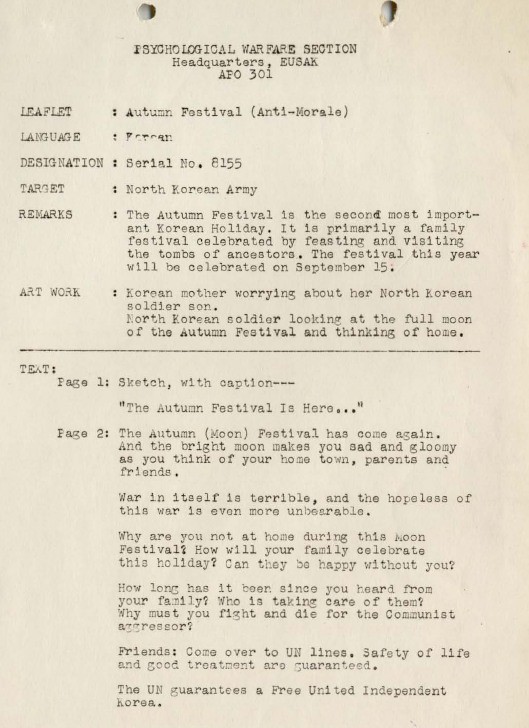
How propaganda leaflet airdrop packets were prepared. From “Report on the Psychological Warfare Conducted by the Eighth Army Units in Korea”

Related products
-
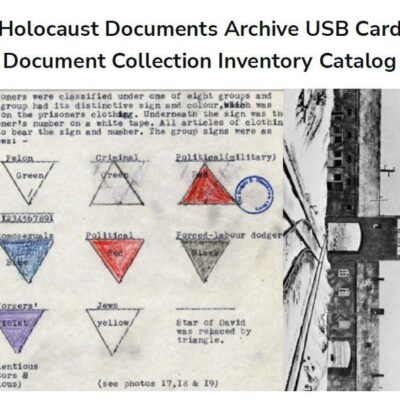
Holocaust Document Archive PDF file – Inventory Catalog of Document Collection
$3.94 Add to Cart -
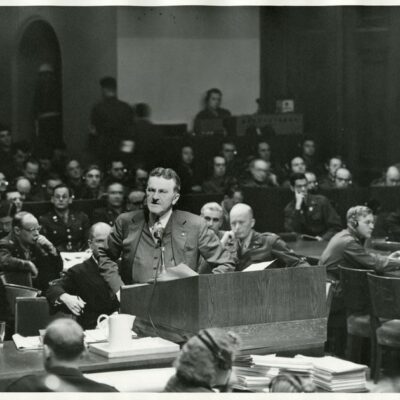
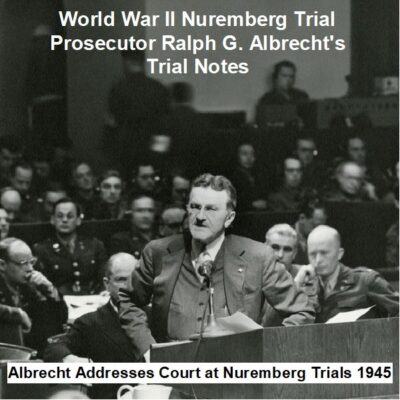
Trial Notes of Ralph G. Albrecht, Prosecutor at the Nuremberg Trials of World War II
$3.94 Add to Cart -
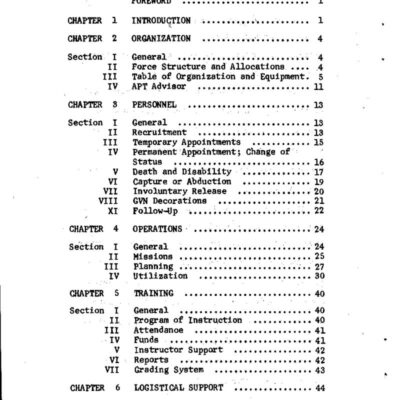
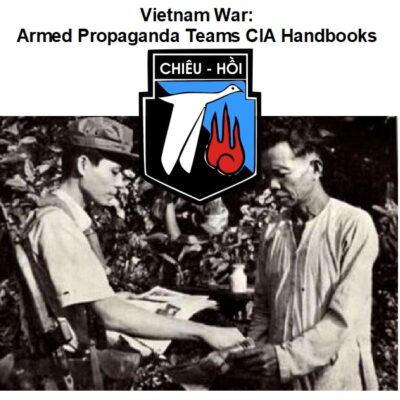
Vietnam War: Armed Propaganda Teams CIA Handbooks
$1.99 Add to Cart -

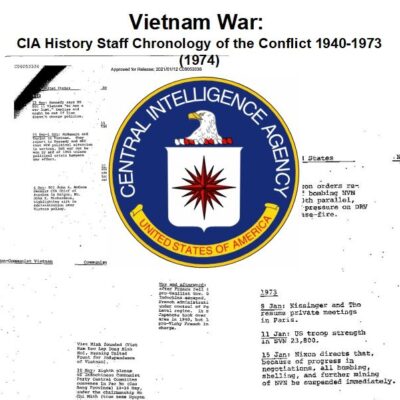
Vietnam War: CIA Chronology of the Conflict, 1940-1973 (1974)
$1.99 Add to Cart